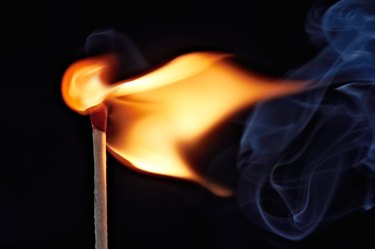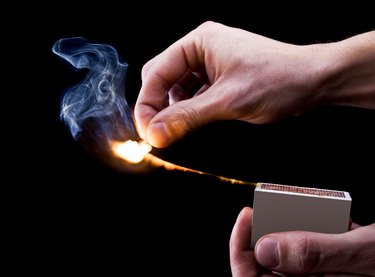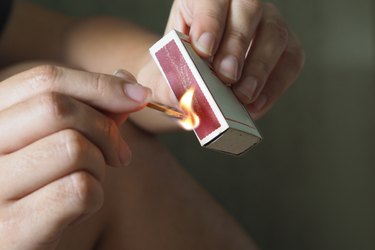
We've all seen tough guys in movies strike a match on their stubble or even with their fingers, but is that actually possible, or is it just movie magic? As it turns out, lighting a match on various surfaces is very possible, given the right conditions and the right kind of matches. To avoid breaking and wasting matches, it's important to understand how matches work and why it is plainly impossible to light safety matches without the strike surface.
How Do Matches Work?
Video of the Day
Matches have been around for a surprisingly long time, as far back as the 1200s. They were originally sulfur-based, but in the 1830s, white phosphorus was included to improve the probability of igniting. Eventually, white phosphorus was discovered to be toxic, building up in the body until major surgery was the only alternative to a wasting death. Modern match heads are composed of potassium chlorate, with sulfur and antimony mixed in to make the match burn hotter.
This mixture will not ignite on its own, but when drawn across the strike strip, made from a non-toxic mixture of red phosphorus and an abrasive like powdered glass, the friction causes heat which changes a tiny amount of the strike strip's red phosphorus into white phosphorus.
The white phosphorus then interacts with the potassium chlorate in the heat to create ignition. This amount of white phosphorus is so small and is burned off so fast, that it is non-toxic and safe (aside from causing fire, of course).
Safety Match Basics

Because the ignition and fuel chemicals are kept separate, the matches cannot light spontaneously, leading to the term "safety" matches. "Strike anywhere" matches don't need the strike strip, because they have a small pocket of phosphorus sesquisulfide, a stable and non-toxic ignition chemical.
By carefully dragging the tip of the match across a rough surface, the friction causes enough heat to ignite the phosphorus sesquisulfide, which then ignites the potassium chlorate which will burn hot and long enough to ignite the match stick.
Lighting a Match with Your Fingers
As you can see, safety matches cannot be ignited without the strike strip, so you cannot light them with your fingers. Strike anywhere matches, however, can be lit simply by briskly scratching the tip of the match with your fingernail. Any rough surface, such as brick or stone, will also serve to ignite the tip.
Checking out a visual demonstration of how to ignite a match with your fingernail can help. You can do this either by dragging the edge of the fingernail across the head or flicking the match at a glancing angle. Waterproof matches are coated in paraffin wax or lacquer, which can make them more difficult to light, requiring multiple flicks or scratches.

When striking a match on a rough surface other than a strike strip, use more force than with a strip and move slowly to build up heat and avoid breaking the matchstick or wearing off the ignition tip. You should be extremely cautious when lighting a match this way to avoid burning yourself; also, never allow children to light matches this way (or play with matches at all).